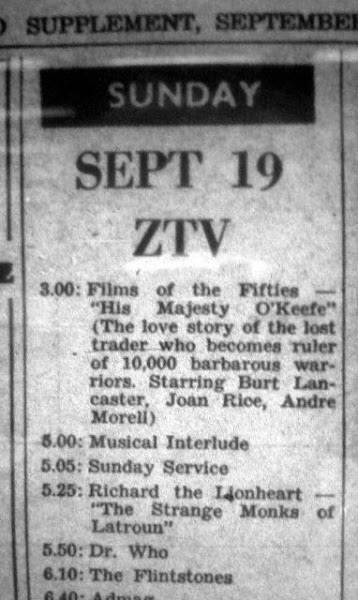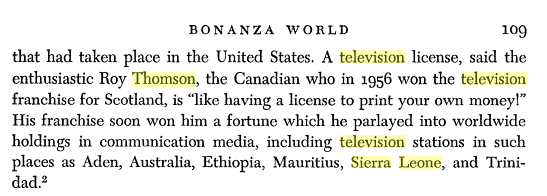Now - bear in mind that missing episodes lore holds that the following is true:
That was long after the Sierra Leone Broadcasting Corporation's rights to show the story must have expired; according to Broadwcast, The Savages first screened in Sierra Leone from 24 July to 14 August 1970.
- There have been reasonably reliable reports that the 1966 William Hartnell story, The Savages, was shown in Sierra Leone in the early 1980s.
Broadwcast also says that the reports in question were from:
'a third party who related the story of a friend's uncle who saw an episode during a visit to Freetown in 1982 or 1983: it was in black and white and featured "the first one with the white hair" and "cavemen living in a wilderness outside a futuristic city who were captured and put in a machine and tortured."'
[Link here - although Broadwcast is in fact down as I write. You may want to come back to this when it's fixed. Although, on the other hand, you could just take my word for it that I've quoted what it says correctly, damn it.]In his book, Wiped!, Richard Molesworth is brimming with confidence about this. He describes the reports as 'very credible' and says that it's 'almost certain that at least The Savages was screened in 1984' (page 380 of the second edition, 2013).
Honestly? If Broadwcast and Wiped! are talking about the same 'reports', and there's no more to them than Broadwcast suggests, then 'very credible' is over-stating the case a little, it seems to me.
But, anyway. It may be that Richard has since changed his mind, in the light of later reports that all of the SLBC's Doctor Who prints were returned to London in 1974. Not least this report, from that
'Yes I have visited sierra leonne .and I do posses there programme traffic records .I can tell you all Doctor Who prints were sent back to london in 1974.'
[From a Q&A on 20 July 2014, quoted here, courtesy of the indefatigable FordTimelord of PMF].And now back to that picture quiz. You thought I'd forgotten about it, didn't you?
Picture 1 is from the Amicus Productions/American International Pictures film, At the Earth's Core, starring Peter Cushing and Doug McClure (you may remember him from such films as, um, At the Earth's Core).
Peter Cushing plays more or less the same character in both. And At the Earth's Core features definite cavemen outside what might, broadly speaking, be regarded as a futuristic city - to which they're taken to be tortured/sacrificed to the Mahars.
Not in a 'machine' admittedly. But there's a mysterious egg-shaped thing that seems to serve no particular purpose, if that's any use to you.
Moreover, the film was distributed at one time by Orion Pictures, who acquired American International Pictures' catalogue through their acquisition of Filmways Inc in 1981/82.
And - coincidentally - Orion Pictures were hawking their wares at the very same MIP-TV event in Cannes in April 1983 that was attended (for the first time) by representatives of the Sierra Leone Broadcasting Service.
That's from page 44 of the 2 May 1983 edition of Broadcasting, which you can find here.
Thus, the grandiosely-named SierraLeone Doug McClure Conjecture is that the story that third party's friend's uncle saw on Sierra Leone TV in the early 1980s wasn't The Savages at all - it was At the Earth's Core, which was probably available fairly cheap, and had certainly been sold to other broadcasters by that time. In the UK, it premièred on BBC One on 14 December 1980.
Oh, and just for completeness - obviously, At the Earth's Core isn't in black and white. But Sierra Leone didn't have colour TV at all until 1978, and only in Freetown. Odds are that the uncle was watching a monochrome set.
OK, OK - it's not a very exciting conjecture. And certainly not proved (or, in all probability, provable). But, for what it's worth, there it is.
OK, OK - it's not a very exciting conjecture. And certainly not proved (or, in all probability, provable). But, for what it's worth, there it is.































